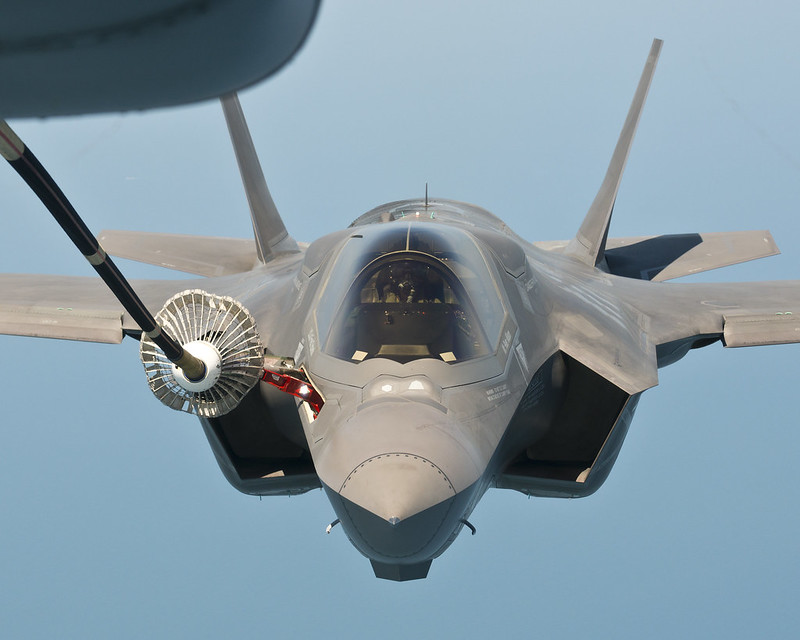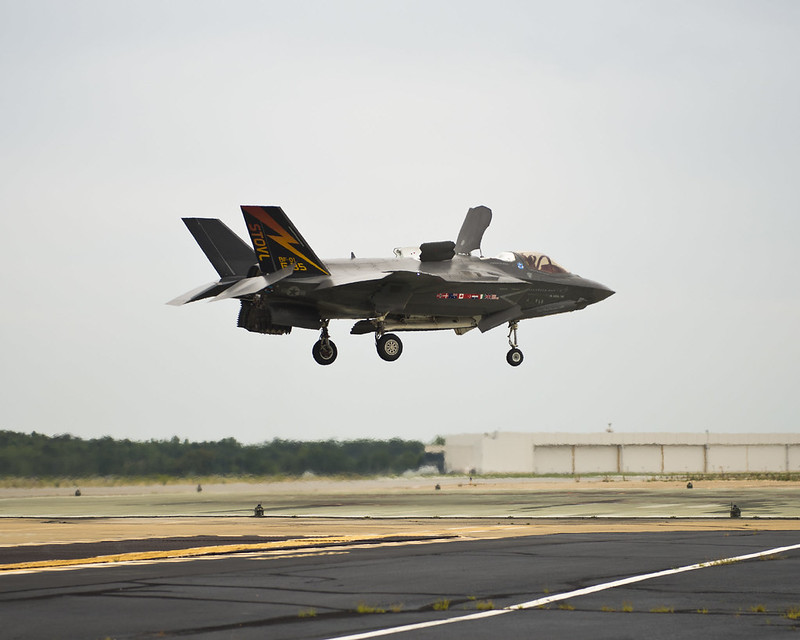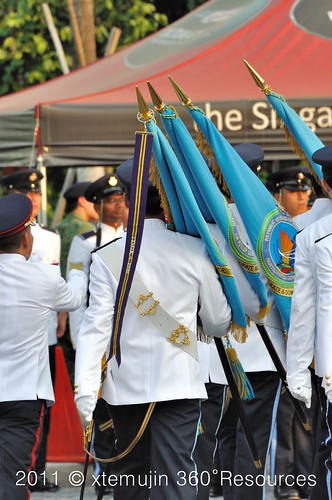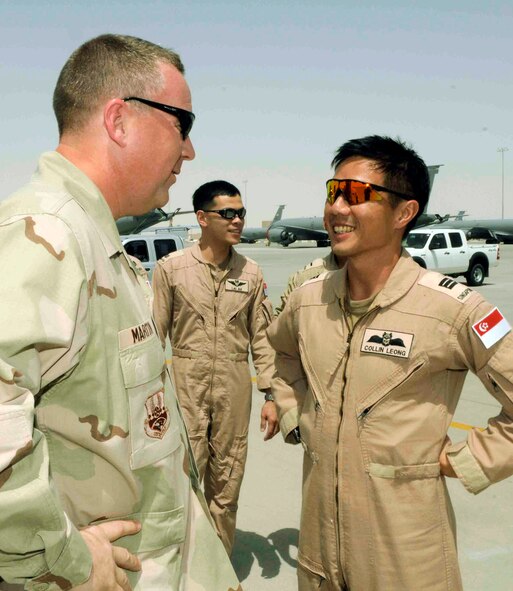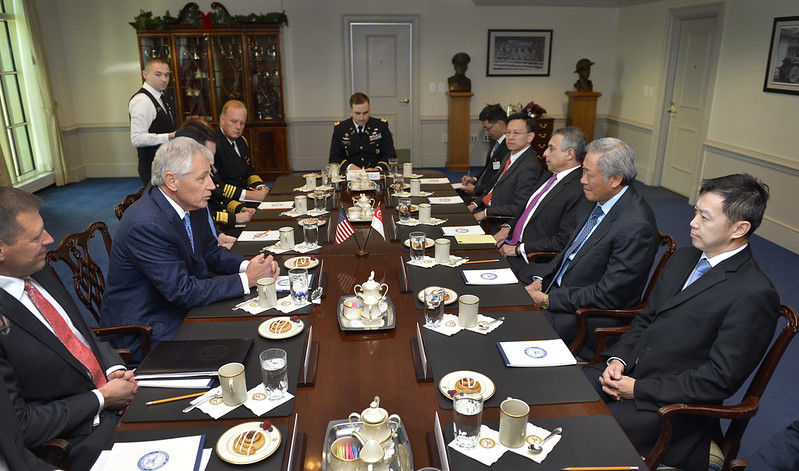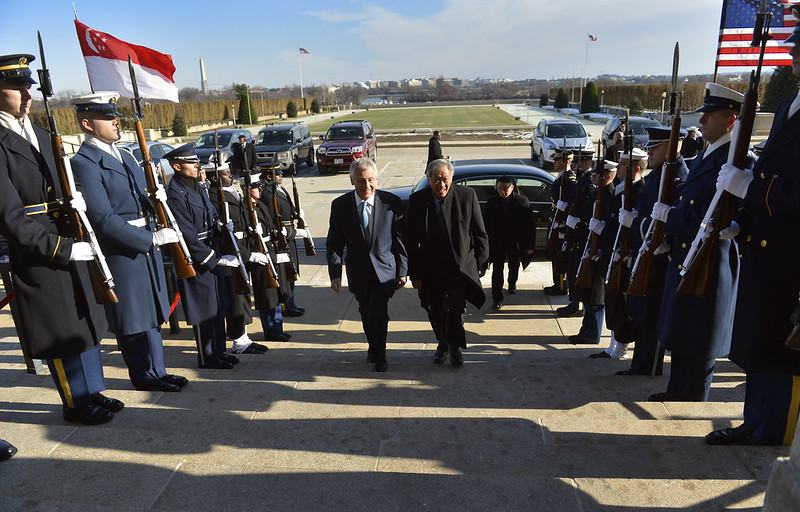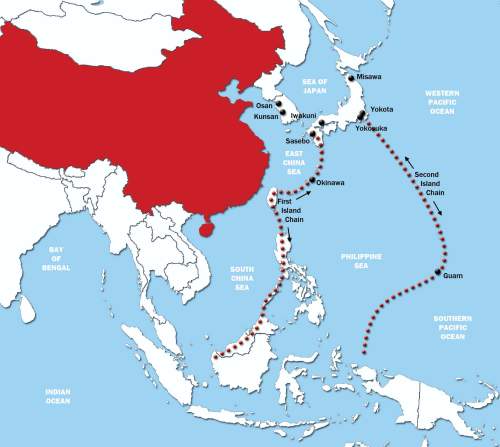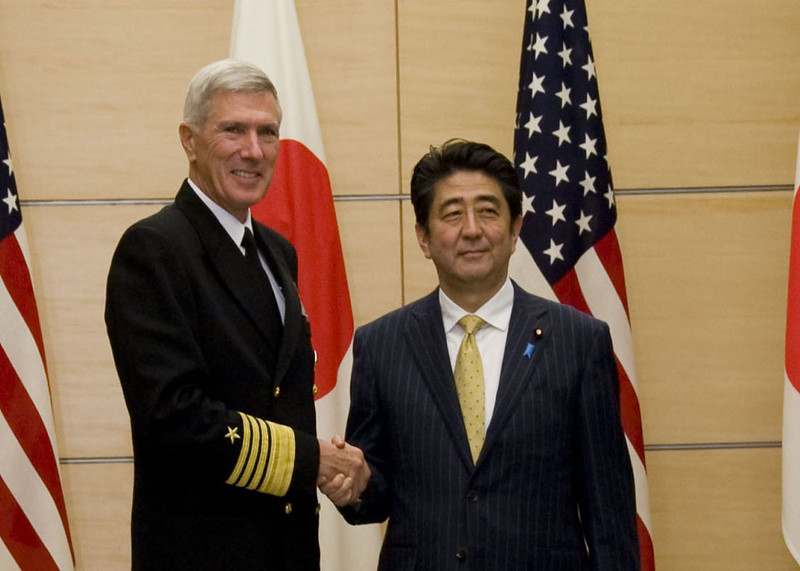Training to contribute to Coalition Air Power in campaigns on Land or at Sea
BANDAR SERI BEGAWAN, Brunei -- A Republic of Singapore Air Force (RSAF) F-15SG deploys flares during the 4th biennial Brunei Darussalam International Defense Exhibition, at the BRIDEX Exhibition Center in Bandar Seri Begawan, Brunei, Dec. 5, 2013. (U.S. Air Force photo/Master Sgt. Jerome S. Tayborn)
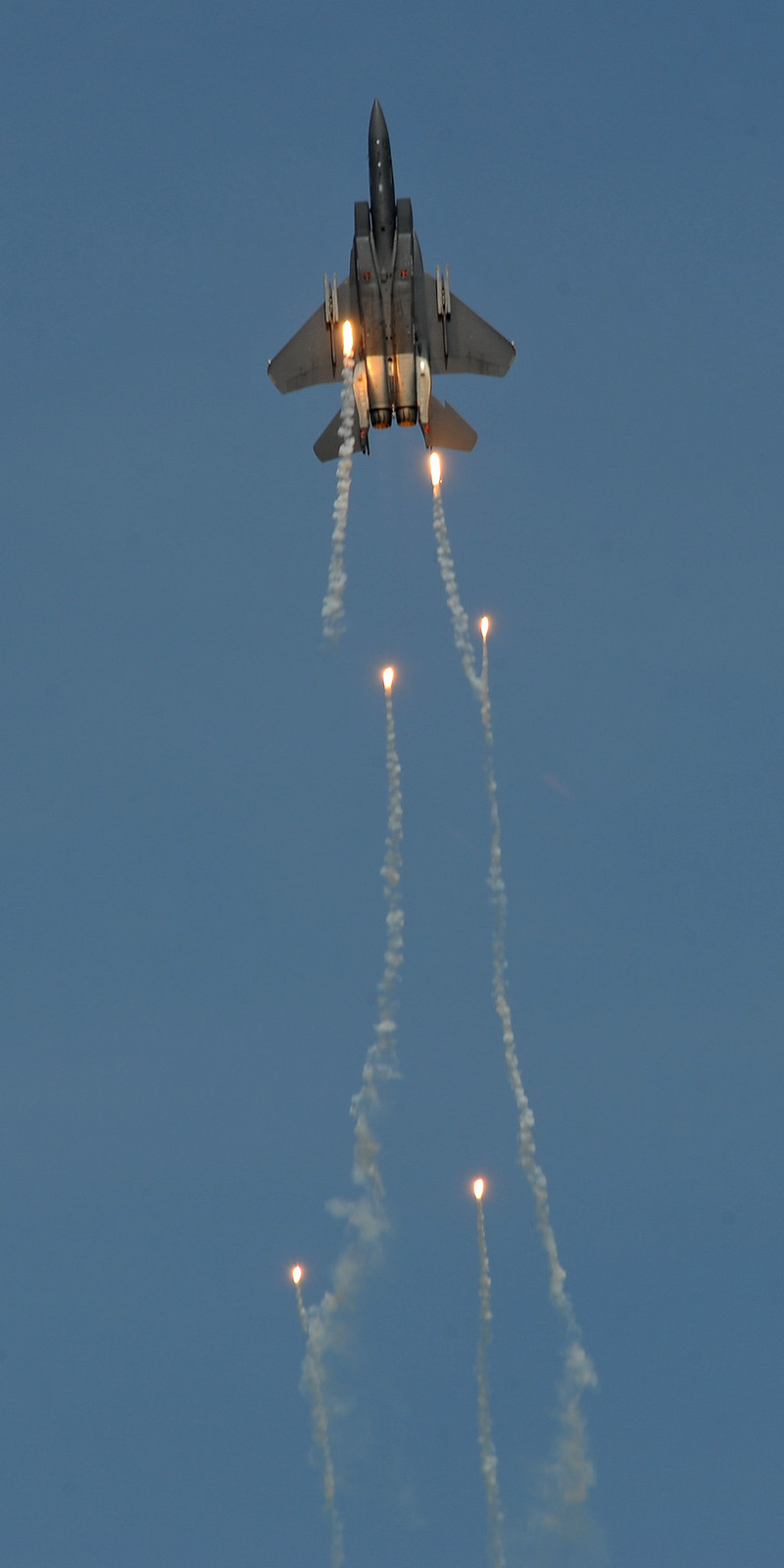
Having been dealt a geo-strategically disadvantaged hand at the country's formation on 9 August 1965 in the mist of tension with its ambitious neighbours, Singapore has to build military capabilities that it needs, first, and that has been the country's singular focus since August 1967. The SAF is not an expeditionary army, nor is the Singapore Navy a blue water navy; but it is the world's smallest country with a tertiary air force. Singapore's lack of depth has resulted in a clear focus on the building the basic force structure for regional over-match, if threatened; and the RSAF's capabilities serve to deter larger powers from acting unilaterally and buys valuable time for the citizen soldiers should they be required to engage in the forward defence of Singapore. Over the years, along with falling birth rates and as the SAF became more capable the duration of service required of Singapore men, as citizen-soldiers, has been reduced. This means the SAF is able to conduct manoeuvre warfare in the near abroad, in a synchronised manner while utilising its air and naval power to destroy or disrupt enemy C4I, lines of communications, logistics; and attack enemy operational reserves. See this video for background on the 50 minute total lock-down of Singapore's busy airspace because of an airspace intrusion (due to an aircraft entering Singapore airspace with no flight plan) in January 2008 to get an idea of Singapore's integrated air defence capabilities: [nomedia="http://www.youtube.com/watch?v=7oCeEHLsIm4"]Guardian of Our Skies - YouTube[/nomedia].
Below, Minister for Defence Dr Ng Eng Hen (centre) accompanied by Minister of State for Defence Dr Mohamad Maliki Bin Osman (2nd from right), unveiling a plaque to commemorate the achievement of FOC by the F-15SG on 18 September 2013.

On 18 September 2013, Dr Ng said in his speech:-
Below is an extract of an article by David Boey on air-land integration that does a wonderful job describing the narrative for Exercise Forging Sabre 2013. The sequence of events for the exercise is quoted below:

Below, a Flight Engineer from the Peace Prairie detachment preparing a General Purpose Machine Gun to be mounted at the doors of the CH-47D Chinook helicopter before a mission. The Chinook has been activated to insert a team of Commandos into hostile territory, as part of Exercise Forging Sabre 2013.

Below, an Aerial Gunner on a Singaporean Chinook using his machine gun to apply suppressive fire to defend his helicopter, in Arizona, USA; as part of Exercise Forging Sabre 2013.

Below, one of two Singaporean Chinook deployed from Grand Prairie, Texas, gets ready to take to the skies, in Arizona, USA. The Chinook was activated to insert a team of Commandos into hostile territory. These Commandos from the Singapore Army will act as 'eyes' on the ground. Together with the Unmanned Aerial Vehicles, they provide a clear situation picture of the battlefield for the Division Strike Centre.

It is important to train Singaporean troops in realistic conditions abroad that broadly simulate war time scenarios. Exercise Forging Sabre 2013 is a wonderful opportunity for the army, air force and navy to work together, as one to shape the land battle. The act of training provide deterrence to any aggressor with hostile intent.
BANDAR SERI BEGAWAN, Brunei -- A Republic of Singapore Air Force (RSAF) F-15SG deploys flares during the 4th biennial Brunei Darussalam International Defense Exhibition, at the BRIDEX Exhibition Center in Bandar Seri Begawan, Brunei, Dec. 5, 2013. (U.S. Air Force photo/Master Sgt. Jerome S. Tayborn)

Having been dealt a geo-strategically disadvantaged hand at the country's formation on 9 August 1965 in the mist of tension with its ambitious neighbours, Singapore has to build military capabilities that it needs, first, and that has been the country's singular focus since August 1967. The SAF is not an expeditionary army, nor is the Singapore Navy a blue water navy; but it is the world's smallest country with a tertiary air force. Singapore's lack of depth has resulted in a clear focus on the building the basic force structure for regional over-match, if threatened; and the RSAF's capabilities serve to deter larger powers from acting unilaterally and buys valuable time for the citizen soldiers should they be required to engage in the forward defence of Singapore. Over the years, along with falling birth rates and as the SAF became more capable the duration of service required of Singapore men, as citizen-soldiers, has been reduced. This means the SAF is able to conduct manoeuvre warfare in the near abroad, in a synchronised manner while utilising its air and naval power to destroy or disrupt enemy C4I, lines of communications, logistics; and attack enemy operational reserves. See this video for background on the 50 minute total lock-down of Singapore's busy airspace because of an airspace intrusion (due to an aircraft entering Singapore airspace with no flight plan) in January 2008 to get an idea of Singapore's integrated air defence capabilities: [nomedia="http://www.youtube.com/watch?v=7oCeEHLsIm4"]Guardian of Our Skies - YouTube[/nomedia].
Below, Minister for Defence Dr Ng Eng Hen (centre) accompanied by Minister of State for Defence Dr Mohamad Maliki Bin Osman (2nd from right), unveiling a plaque to commemorate the achievement of FOC by the F-15SG on 18 September 2013.

On 18 September 2013, Dr Ng said in his speech:-
"The RSAF's current orbat, with the F-15SG and other advanced RSAF systems like the G550 airborne early warning aircraft, the SPYDER air defence system and the ASTER-30 surface-to-air missile system, provides a robust and multi-layered air defence shield to protect Singapore against a spectrum of airborne threats."
Below is an extract of an article by David Boey on air-land integration that does a wonderful job describing the narrative for Exercise Forging Sabre 2013. The sequence of events for the exercise is quoted below:
Below, aircrew from the RSAF and their American Army counterparts from the Peace Prairie detachment conducting a mission brief, as part of Exercise Forging Sabre 2013.David Boey said:Life imitates art? SAF demonstrates Dynamic Targeting during Exercise Forging Sabre 2013

...Arrayed before NATO Hill were targets the SAF was tasked to demolish within minutes. Whether by intention or uncanny coincidence, the narrative for Forging Sabre's light and sound show reflects the logical sequence for taking out conventional threats.
From here, we have a ringside seat as the SAF's meanest and deadliest war machines move into action. It was executed according to the sequence below.
Cripple the rocket launchers
First to go was a remote-controlled vehicle that ran for its life along a sinuous desert dirt track, raising a banner of dust in its wake. This simulated a moving target, in this case a rocket launcher. The moving vehicle was tracked by SAF sensors that guided a laser JDAM bomb dropped from a high flying F-15SG warplane, orbiting at some 16,000 feet, dead on target. After the strike, the narrative indicated that the F-15SG returned to its holding area to await orders to take out another target. As each F-15SG can carry up to 15 JDAMs, the war load of the RSAF's most advanced warplane is noteworthy, considering Singapore has bought 24 of these combat proven warplanes.
Blind the anti-aircraft radars
Next on the target list were radars for the enemy's anti-aircraft weapons. Two F-16 warplanes entered the arena to deliver a pair of laser guided bombs on a "radar site". As the bombs blew the target apart, the F-16s left the scene at high speed, releasing a trail of blazing flares that could have deceived heat-seeking missiles launched against them. The evasive manoeuvres were not just for show: during the air strike mock SAMs were launched against the jets to simulate an enemy air defences abuzz with retaliatory moves.
Clip the wings
After this strike came the main strike team, made up of just two F-15SGs. Each carried four Mark 84 2,000-pound bombs - the largest bombs in the RSAF's arsenal - to demolish aircraft fuel and ammunition storage at a hostile air base. As the bombs blasted the simulated air base, they created a tall column of smoke that marked the death of an air force. The narrator noted that a real air base target may involve eight or more F-15SGs, and that single strike by a fraction of what would be fielded in a shooting war gave observers some idea of the damage such a main strike could inflict.
It is interesting to note that the opening phases of the Forging Sabre firepower demo placed air bases and surface to air missile sites high on the target list, as such a game plan was indeed pursued by air power planners who fought in Iraq and the former Yugoslavia. SAF defence planners understand that warplanes are weapons only when they are in the air, sustained with weapons, fuel and pilots. A warplane on the ground is a high value target just waiting to have its wings clipped.

Shred the tank columns
In came the Apache attack helicopters that drizzled a simulated town with rockets fired at a column of enemy vehicles parked in civilian areas. Red buildings indicated civilian targets that could not be hit as these could result in civilian casualties. The cloud of rockets that smashed the tank column would have shredded enemy armour and stopped a real one in its tracks.

Strike the command centre
The finale came from the Singapore Army's HIMARS - its name means High Mobility Artillery Rocket System - which were tasked to destroy static, high value targets such as command posts. The observers on NATO Hill scrutinised the live firing area to pick out the HIMARS launchers...
<snip>


Below, a Flight Engineer from the Peace Prairie detachment preparing a General Purpose Machine Gun to be mounted at the doors of the CH-47D Chinook helicopter before a mission. The Chinook has been activated to insert a team of Commandos into hostile territory, as part of Exercise Forging Sabre 2013.

Below, an Aerial Gunner on a Singaporean Chinook using his machine gun to apply suppressive fire to defend his helicopter, in Arizona, USA; as part of Exercise Forging Sabre 2013.

Below, one of two Singaporean Chinook deployed from Grand Prairie, Texas, gets ready to take to the skies, in Arizona, USA. The Chinook was activated to insert a team of Commandos into hostile territory. These Commandos from the Singapore Army will act as 'eyes' on the ground. Together with the Unmanned Aerial Vehicles, they provide a clear situation picture of the battlefield for the Division Strike Centre.

It is important to train Singaporean troops in realistic conditions abroad that broadly simulate war time scenarios. Exercise Forging Sabre 2013 is a wonderful opportunity for the army, air force and navy to work together, as one to shape the land battle. The act of training provide deterrence to any aggressor with hostile intent.
Last edited:














